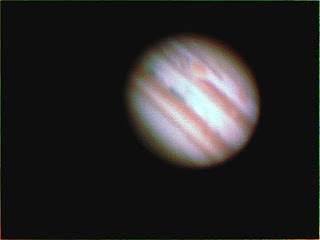Here are some images I took of Jupiter with the 14 inch in decidedly less-than-average seeing. They are a long way short of what I would like to see, and I've used different variations to process them. Captured at 640x480 with a Microsoft LifeCam with 1000 frames per capture. Stacked and processed in Registax 6, with final processing in Photoshop. The big challenge in poor seeing is ability to reach focus. For comparison, look at the images of Saturn taken with my ETX 125 at Cape Cod last summer. The atmosphere at Cape Cod had long, slow ripples with long periods of steadiness, greatly simplifying focus. In these pix, Jupiter's image was rippling as if it was viewed through rapidly rippling water.
Nevertheless, the Great Red Spot (GRS) is clearly visible in these images, with an area of turbulence next to it. The images were captured over an hour and the motion of the GRS is clearly visible between the first and second image.
 |
| Output from Photoshop. Note GRS |
 |
| Note the position of the GRS compared to the fist image |
.jpg) |
| Output from Registax after stacking and wavelet processing. |
 |
| Output with minimal Photoshop processing (after Registax) |


.jpg)







No comments:
Post a Comment